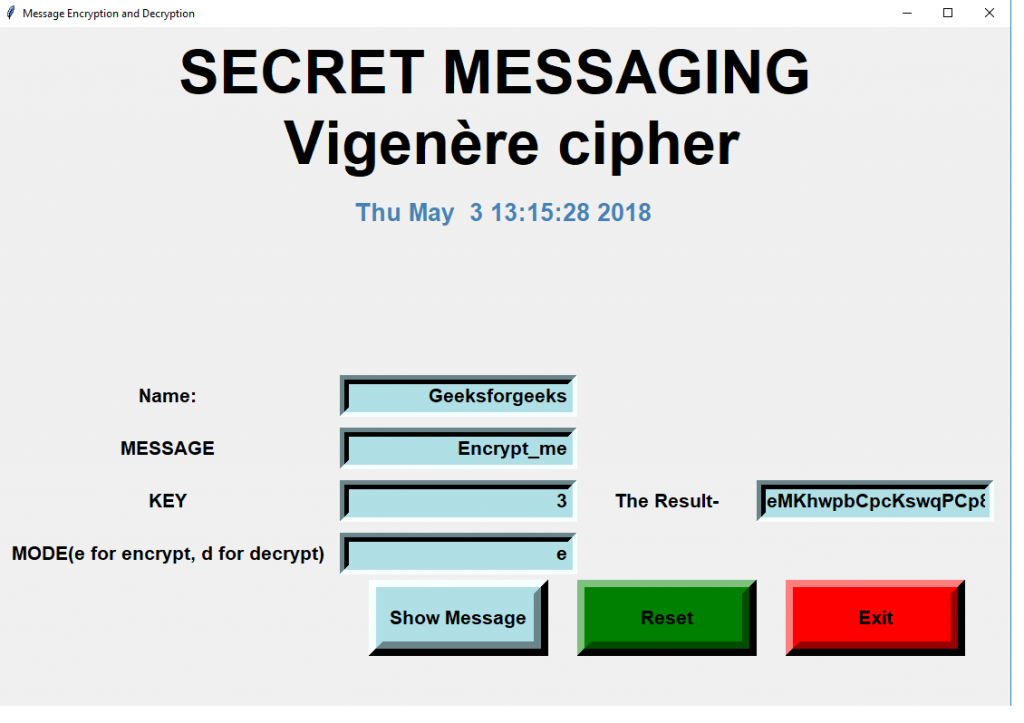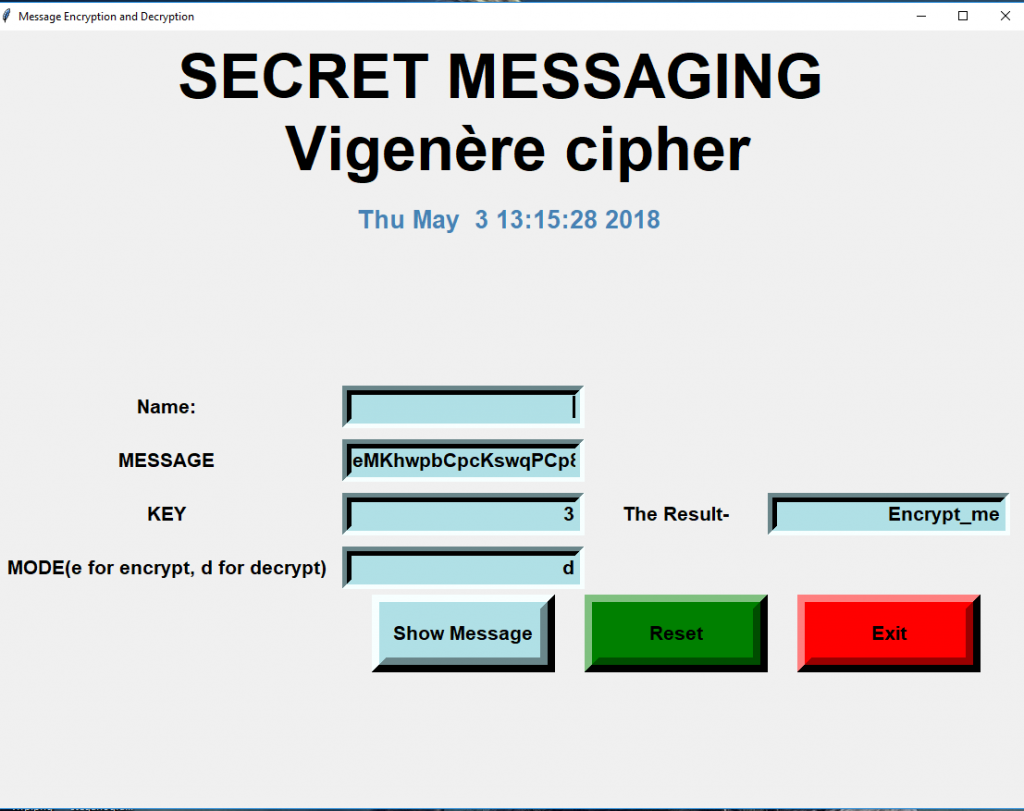Python|使用 Tkinter 进行消息编码-解码
先决条件:Tkinter 基础
Python为开发 GUI(图形用户界面)提供了多种选择。在所有的 GUI 方法中,tkinter 是最常用的方法。它是Python随附的 Tk GUI 工具包的标准Python接口。带有 tkinter 的Python输出创建 GUI 应用程序的最快和最简单的方法。
Python提供了 Tkinter 工具包来开发 GUI 应用程序。现在,这取决于开发人员的想象力或必要性,他/她想使用这个工具包开发什么。让我们尝试根据 Vigenère 密码实现一个消息加解密应用程序,它可以使用密钥对消息进行加密,也可以使用相同的密钥对加密后的哈希进行解密。
Modules used in the project :
Tkinter -> GUI toolkittime datetime base64 -> Vigenère cipher以下是上述想法的实现:
Python3
# import tkinter module
from tkinter import *
# import other necessary modules
import random
import time
import datetime
# creating root object
root = Tk()
# defining size of window
root.geometry("1200x6000")
# setting up the title of window
root.title("Message Encryption and Decryption")
Tops = Frame(root, width = 1600, relief = SUNKEN)
Tops.pack(side = TOP)
f1 = Frame(root, width = 800, height = 700,
relief = SUNKEN)
f1.pack(side = LEFT)
# ==============================================
# TIME
# ==============================================
localtime = time.asctime(time.localtime(time.time()))
lblInfo = Label(Tops, font = ('helvetica', 50, 'bold'),
text = "SECRET MESSAGING \n Vigenère cipher",
fg = "Black", bd = 10, anchor='w')
lblInfo.grid(row = 0, column = 0)
lblInfo = Label(Tops, font=('arial', 20, 'bold'),
text = localtime, fg = "Steel Blue",
bd = 10, anchor = 'w')
lblInfo.grid(row = 1, column = 0)
rand = StringVar()
Msg = StringVar()
key = StringVar()
mode = StringVar()
Result = StringVar()
# exit function
def qExit():
root.destroy()
# Function to reset the window
def Reset():
rand.set("")
Msg.set("")
key.set("")
mode.set("")
Result.set("")
# reference
lblReference = Label(f1, font = ('arial', 16, 'bold'),
text = "Name:", bd = 16, anchor = "w")
lblReference.grid(row = 0, column = 0)
txtReference = Entry(f1, font = ('arial', 16, 'bold'),
textvariable = rand, bd = 10, insertwidth = 4,
bg = "powder blue", justify = 'right')
txtReference.grid(row = 0, column = 1)
# labels
lblMsg = Label(f1, font = ('arial', 16, 'bold'),
text = "MESSAGE", bd = 16, anchor = "w")
lblMsg.grid(row = 1, column = 0)
txtMsg = Entry(f1, font = ('arial', 16, 'bold'),
textvariable = Msg, bd = 10, insertwidth = 4,
bg = "powder blue", justify = 'right')
txtMsg.grid(row = 1, column = 1)
lblkey = Label(f1, font = ('arial', 16, 'bold'),
text = "KEY", bd = 16, anchor = "w")
lblkey.grid(row = 2, column = 0)
txtkey = Entry(f1, font = ('arial', 16, 'bold'),
textvariable = key, bd = 10, insertwidth = 4,
bg = "powder blue", justify = 'right')
txtkey.grid(row = 2, column = 1)
lblmode = Label(f1, font = ('arial', 16, 'bold'),
text = "MODE(e for encrypt, d for decrypt)",
bd = 16, anchor = "w")
lblmode.grid(row = 3, column = 0)
txtmode = Entry(f1, font = ('arial', 16, 'bold'),
textvariable = mode, bd = 10, insertwidth = 4,
bg = "powder blue", justify = 'right')
txtmode.grid(row = 3, column = 1)
lblService = Label(f1, font = ('arial', 16, 'bold'),
text = "The Result-", bd = 16, anchor = "w")
lblService.grid(row = 2, column = 2)
txtService = Entry(f1, font = ('arial', 16, 'bold'),
textvariable = Result, bd = 10, insertwidth = 4,
bg = "powder blue", justify = 'right')
txtService.grid(row = 2, column = 3)
# Vigenère cipher
import base64
# Function to encode
def encode(key, clear):
enc = []
for i in range(len(clear)):
key_c = key[i % len(key)]
enc_c = chr((ord(clear[i]) +
ord(key_c)) % 256)
enc.append(enc_c)
return base64.urlsafe_b64encode("".join(enc).encode()).decode()
# Function to decode
def decode(key, enc):
dec = []
enc = base64.urlsafe_b64decode(enc).decode()
for i in range(len(enc)):
key_c = key[i % len(key)]
dec_c = chr((256 + ord(enc[i]) -
ord(key_c)) % 256)
dec.append(dec_c)
return "".join(dec)
def Ref():
print("Message= ", (Msg.get()))
clear = Msg.get()
k = key.get()
m = mode.get()
if (m == 'e'):
Result.set(encode(k, clear))
else:
Result.set(decode(k, clear))
# Show message button
btnTotal = Button(f1, padx = 16, pady = 8, bd = 16, fg = "black",
font = ('arial', 16, 'bold'), width = 10,
text = "Show Message", bg = "powder blue",
command = Ref).grid(row = 7, column = 1)
# Reset button
btnReset = Button(f1, padx = 16, pady = 8, bd = 16,
fg = "black", font = ('arial', 16, 'bold'),
width = 10, text = "Reset", bg = "green",
command = Reset).grid(row = 7, column = 2)
# Exit button
btnExit = Button(f1, padx = 16, pady = 8, bd = 16,
fg = "black", font = ('arial', 16, 'bold'),
width = 10, text = "Exit", bg = "red",
command = qExit).grid(row = 7, column = 3)
# keeps window alive
root.mainloop()输出 :
加密窗口 –

解密窗口 –
